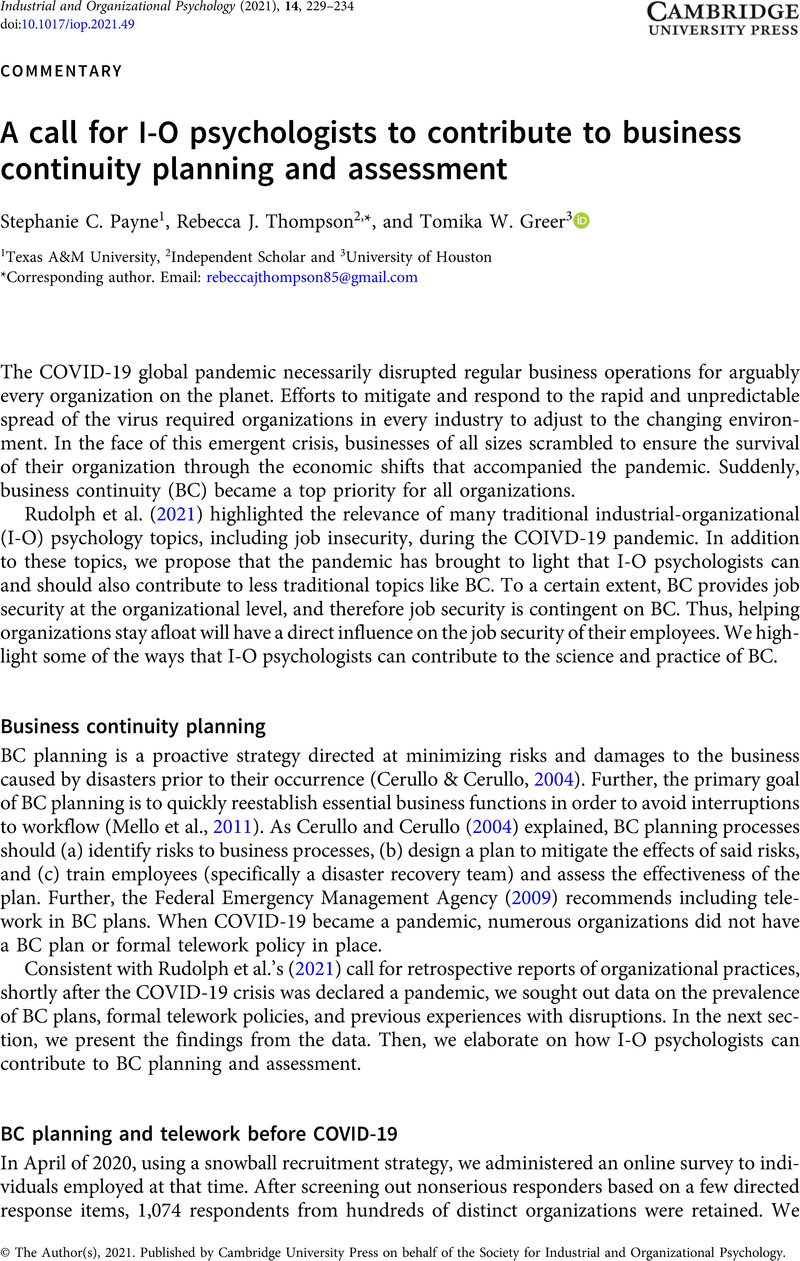No CrossRef data available.
Article contents
A call for I-O psychologists to contribute to business continuity planning and assessment
Published online by Cambridge University Press: 24 May 2021
Abstract
An abstract is not available for this content so a preview has been provided. Please use the Get access link above for information on how to access this content.

- Type
- Commentaries
- Information
- Industrial and Organizational Psychology , Volume 14 , Special Issue 1-2: Special Pandemic Issue , June 2021 , pp. 229 - 234
- Copyright
- © The Author(s), 2021. Published by Cambridge University Press on behalf of the Society for Industrial and Organizational Psychology.
References
Allen, T. D., Golden, T. D., & Shockley, K. M. (2015). How effective is telecommuting? Assessing the status of our scientific findings. Psychological Science in the Public Interest, 16, (2) 40–68. https://journals.sagepub.com/home/psi
10.1177/1529100615593273CrossRefGoogle ScholarPubMed
Baltes, B. B., Briggs, T. E., Huff, J. A., Wright, J. A., & Neuman, G. A. (1999). Flexible and compressed workweek schedules: A meta-analysis of their effects on work-related criteria. Journal of Applied Psychology, 84(4), 496–513.10.1037/0021-9010.84.4.496CrossRefGoogle Scholar
Cerullo, V., & Cerullo, M. J. (2004). Business continuity planning: A comprehensive approach. Information Systems Management, 21(3), 70–78. https://doi.org/10.1201/1078/44432.21.3.20040601/82480.11
CrossRefGoogle Scholar
Federal Emergency Management Agency. (2009). Continuity guidance circular 1: Continuity guidance for non-federal entities. http://www.fema.gov/pdf/about/org/ncp/cont_guidance1.pdf
Google Scholar
Greer, T. W., & Payne, S. C. (2014). Overcoming telework challenges: Outcomes of successful telework strategies. Psychologist-Manager Journal, 17(2), 87–111.10.1037/mgr0000014CrossRefGoogle Scholar
Keiser, N. L., & Arthur, W., Jr. (2021). A meta-analysis of the effectiveness of the after-action review (or debrief) and factors that influence its effectiveness. Journal of Applied Psychology. Advance online publication. https://doi.org/10.1037/apl0000821
Google Scholar
Mello, A. A. A., de Assis Goncalves, F., & Lima, F. (2011). Lessons learned from September 11th: Telework as an organizational resource to the business continuity planning (BCP), Japanese Journal of Telework, 9(1), 46–51. https://doi.org/10.24505/jats.9.1_46
Google Scholar
Rudolph, C. W., Allan, B., Clark, M., Hertel, G., Hirschi, A., Kunze, F., Shockley, K., Shoss, M., Sonnentag, S., & Zacher, H. (2021). Pandemics: Implications for research and practice in industrial and organizational psychology. Industrial and Organizational Psychology: Perspectives on Science and Practice, 14(1), 1–35.Google Scholar
U.S. Department of Homeland Security. (2020, May 19). CISA’s guidance on essential critical infrastructure workers. https://www.cisa.gov/sites/default/files/publications/Version_3.1_CISA_Guidance_on_Essential_Critical_Infrastructure_Workers_0.pdf
Google Scholar




